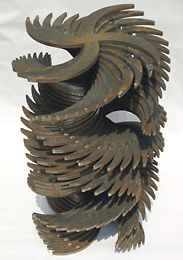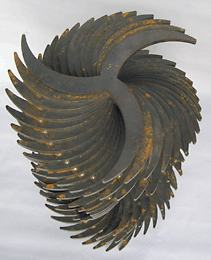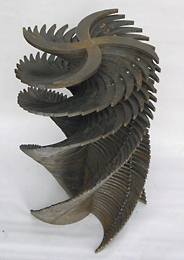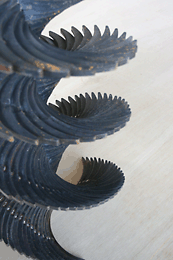Kakiseni, 8 July 2008
Abdul Multhalib Musa: Travelling with Moving
by Eva McGovern
Stillness. Stasis. Movement. Action. Sitting in traffic on the way to Wei Ling Gallery to see Abdul Multhalib Musa’s recent solo show Twist, I didn’t have a book, newspaper, I-pod or other useful strategy to pass the time en route. I glanced at my taxi driver who was reading an article on the aphrodisiac qualities of watermelon, which sadly, were of no interest to me.
Therefore lost in thought, I contemplated the notion of travelling without moving which is what immediately struck me when first confronted with Multhalib Musa’s work. Somehow the stillness of the cars trapped on the road, the frustration of motorists impatient to arrive at their destinations, the stop-start motions of the cars in contrast to the seamless buzzing of traffic on the other side of the road all lent themselves appropriately as the starting point to the exhibition. With the geometry of the city all around, I was anticipating precision, chaos, architectural lines and organic punctuations.
I entered Wei Ling Gallery and climbed the stairs to the exhibition space. The very nature of the gallery with its labyrinthine internal architecture, lends itself to an interesting dialogue with the work of Abdul Multhalib Musa, a well established Malaysian abstract sculptor who is also a trained architect. His architectural background resonates strongly in his practice, which explores the possibilities of seemingly rigid metals, in this case, steel and how it can be manipulated to be both precise — in his use of technique and repetition of form — whilst simultaneously fluid and rhythmic.
The exhibition displays two different motifs; a wall based series of steel panels entitled Linear Twist and free standing spiralling sculptures: the Twist series that both take up the entire gallery space. This represents a new body of work for Multhalib Musa (that has evolved from an earlier series) in response to paintings by Yusof Ghani entitled “Biring” exhibited in 2007 at the Gallery. The action and movement from Yusof’s painting’s subject matter, the cock fight, inspired Multhalib Musa to create a series that echos the blurring pace of bodies in motion.
There is a clear and precise delivery of the work, realised by computer design and laser cutting. The Twist sculptures display a mathematic sensibility which is made up of multi-layered blades similar in shape to those found in food blenders or airplane propellers consisting of either two, three of four fins. Stacked to form an undulating screw like totemic structure, the striations from the cut steel etched into the edges of each blade display metallic greys, blues and golds reflecting a myriad of colour which heightens the movement of the sculpture. The Twist series follows on from the artist’s earlier mobiles work and although made of steel and dense in form, there is a certain lightness to these structures. It is easy to imagine them turning in the wind like their lighter spiral mobile counterparts found hanging from household porches. In addition there is a delicacy in design that shows a consciousness of organic forms such as the spiral of a sea shell.
The juxtaposition of motion and stasis is clear, the Twist sculptures display each frame of movement of the whirring blades, methodically measured, the spinning firecracker in slow motion as if in water. Industrial Duchampian figures both ascending and descending the staircases in the gallery. However, unlike the drama of the cockfight from Ghani’s paintings, there never seems to be a moment when this capturing of movement gets out of control, the blades are dull, deliberated corroded to a specific point by the artist and then preserved to become an untouched relic. Reminiscent of Deconstructivist concerns of unpredictability and controlled chaos as seen in the works of architects like Daniel Libeskind, Rem Koolhaas and Zaha Hadid, the work never turns into architectural meglomania. The monumentality lies in the silence of these relatively small sculptures.
The wall based work possess a different quality, one that is deliberately more organic, more lyrical and sentimental. Each steel panel has had multiple half circles cut into them which is then lifted out of the surface to create patterns similar to sunbursts or fallen leaves. Where as the Twist sculptures have an implied industrial quality the Linear Twist series is meditative, with an iconic natural/spiritual factor that give the work a more implicit meaning, limiting the possibility of multiple interpretation. The real strength of this body of work lies in the free standing sculptures where the artist’s preoccupation with the relationship between art and architecture is much more apparent.
Ultimately it was the dialogue between the gallery space and Multhalib Musa’s work that create a tightly woven and effective total installation. The zig zagging of the gallery’s staircases, hexagonal flooring, exposed brickwork and remnants of the original internal structure create movement within movement. With each floor visually accessible to one another the viewer’s gaze is able to travel both upwards and downwards, as it does when taking in the upward and downward spiralling motion of the sculpture or form bursting from the panels. Coupled with views of the city outside where the eye constantly takes in the motions of a living metropolis, highways, sky scrapers, the organic forms of trees and grass, industrial cranes building one structure after another all echo what was happening inside the gallery. Even the whirring blades of the floor fans on each level seems to become part of the show complimenting the artists inspiration from the built environment.
Reference to Yusof Ghani’s work is strangely absent in the exhibition except for a few lines in the press release which questions the importance of this starting point to the work. This context does not seem to be a crucial inclusion in the construction of the exhibition. The use of painting as a subject to respond to would have been interesting to explore especially with such tectonic work but in this case it seems to disappear from consciousness completely as the sculptures and gallery architecture overwhelm any such concerns.
Abdul Multhalib Musa’s career is going from strength to strength. A former Rimbun Dahan artist, he has exhibited consistently in group and solo shows since 2000 and has been commissioned to create a public sculpture for this year’s upcoming Beijing Olympics. As I left the gallery, anticipation to see how this artist’s practice develops filled my thoughts as I waited to be held in traffic once again in the growing city, like Multhalib Musa’s practice: travelling without moving.
~
Eva McGovern is an independent curator based in Kuala Lumpur. She has recently relocated to Malaysia from London after working in a major contemporary art institution where she organised exhibitions and public programmes. Eva’s primary research interest is contemporary South East Asian art and performance art.





